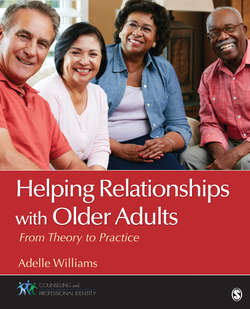Читать книгу Helping Relationships With Older Adults - Adelle M. Williams - Страница 52
На сайте Литреса книга снята с продажи.
Perceptions of Growing Older and Societal Influences
ОглавлениеThe media have a very powerful influence on the way society thinks, feels, and behaves. Mass media, particularly television and movies, define social roles in contemporary culture by presenting a steady and repetitive portrayal of images and a system of messages. The media emphasizes youth and beauty and overly simplistic portrayals of individuals. This emphasis exacerbates the negative image of aging and the elderly in American culture, because the stereotypes of aging are the antithesis of the attributes upon which television and movies thrive (Monsees, 2002).
The mass media play a powerful role in shaping American attitudes, and the media’s portrayal of aging and older people can vary depending on its objective. In promotion of products, older people may be pictured in association with products such as medicine, including those to address incontinence and impotence, dental and digestive aids, and cosmetics to decrease signs of aging (Brownell, Mundorf, & Mundorf, 2006). When the media focus on general television programming or movies for the general public, older persons are typically cast in supporting roles versus leading roles (Hilt & Lipschultz, 2004), which promote stereotypes. Television programming has few older heroes. Older fashion models are rare, and advertising lacks the mature face (Dennis & Thomas, 2007). Repeated exposure to negative images of older adults, limited exposure to elders in more positive and leading roles may continue to lead to devaluing of older adults in society. Examination of the role of the media will highlight the portrayal of older persons and the need to alter this portrayal in Guided Practice Exercise 2.1.
Guided Practice Exercise 2.1
The media have a powerful influence on our viewpoints, and it permeates many aspects of our lives. How do the media portray older persons? Choose one form of media (television, radio, print) and identify both positive and negative images of older adults. Quantify the images and place in a positive or negative category. Now tabulate the columns and discuss the implications of these data with peers and colleagues. Identify ways to improve the representation of older persons in the media and ways to enhance the image of older persons.
Gender plays a role in societal perceptions, and many studies have found that people are more likely to view men as losing general competence or ability with age, yet they are more likely to judge women as needing more help with age (Kite, Stockdale, Whitley, & Johnson, 2005). Because of age stereotypes, the very same behavior in younger versus older individuals is perceived differently. When younger adults forget information, the cause is more likely to be seen as transient and external, such as “that’s a hard thing to remember.” When older people forget, the cause is more likely to be seen as something stable and internal, such as having a poor memory (Kite et al., 2005).
Aging can bring stereotypic reaction and expectations from others, which may interfere with satisfying social interactions. Researchers have found that when older individuals perceive themselves as the target of age discrimination, their sense of well-being is negatively affected (Gartska, Schmitt, Branscombe, & Hummert, 2004). This discrimination can come from anyone, as individuals of all ages tend to judge older people more negatively when compared to younger people (Hess, 2006).
